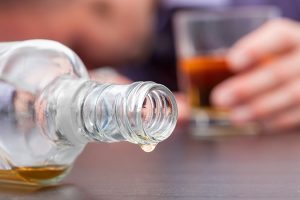A New Predictor of Problem Drinking in Early Adulthood

Drinking alone in youth is a strong predictor of problematic alcohol use in later life, new research suggests.
In a large longitudinal study that followed a national sample of US high school students for 17 years, solitary drinking in adolescence and young adulthood was associated with binge drinking — and prospectively predicted alcohol use disorder (AUD) at age 35 years.
In addition, risk of developing AUD was especially high for women.

Kasey G. Creswell, PhD
“Drinking alone is a red flag for young people, and it is predictive of future alcohol problems above and beyond other well-established risk factors, like binge drinking, frequency of alcohol use, socioeconomic status, and male gender,” lead author Kasey G. Creswell, PhD, associate professor of psychology at Carnegie Mellon University, Pittsburgh, Pennsylvania, told Medscape Medical News.
In fact, the odds of 18-year-old women having alcohol use disorder symptoms at age 35 was 86% higher than for teens who reported drinking only in social settings. For 18-year-old men, it was only 8% higher, Creswell noted.
“So, we really need to pay attention to young women who are drinking alone,” she said.
The findings were published online July 11 in Drug and Alcohol Dependence.
Social Context Key
Many alcohol screening tools contain only questions about frequency and quantity of drinking, but one underappreciated risk factor for the development of problematic drinking is the social context in which adolescents and young adults consume alcohol, Creswell said.
“Most young people who drink alcohol only do it with their friends in social settings, at parties, and so on. Some researchers have even said social use of alcohol among young people is a marker for social well-being, but when young people are drinking alone, that’s where we think the problem lies,” she added.
The investigators analyzed data from the Monitoring the Future (MTF) study, an ongoing epidemiologic study of drug and alcohol use among American youth followed into adulthood.
Annually, since 1975, the MTF study has surveyed nationally representative samples of approximately 15,000 twelfth-grade students from public and private US schools.
The students (aged 18 years) usually complete the survey during a high school class period and then approximately 2400 are randomly selected from each cohort and followed up for 17 years.
Included in the current analysis were 4464 adolescents and 4561 young adults who filled out surveys that asked about their alcohol consumption at three different time points: age 18, age 23-24, and age 35 years. The surveys were conducted between 1981 and 2019.
Overall, about 25% of adolescents and 40% of young adults reported drinking alone.
Unique Predictor
Results showed that solitary alcohol use was a unique predictor of binge drinking and of future AUD at age 35.
“Even after we controlled for frequency of drinking and male sex, factors that are considered to put people at risk for alcohol use disorder, solitary alcohol use was a unique predictor of binge drinking,” Creswell said.
“Our results tell us strongly that young people who are drinking alone are also much more likely to engage in binge drinking,” she added.
Compared with their peers who only drank in social settings, the odds of AUD symptoms at age 35 was 35% higher for adolescents who drank alone.
For young adults aged 23-24 years, that odds ratio was much higher. The odds of young adults who drank alone developing AUD symptoms at age 35 was 60% higher compared with peers who were drinking only in social settings.
Further analyses showed that individuals who were solitary drinkers as teens and young adults also had worse AUD symptoms at age 35.
“We wanted to determine whether solitary drinking at younger ages would predict not just the development of AUD but the severity of alcohol use disorder symptoms, and here the results were even more striking,” Creswell said.
Girls at Highest Risk
The risk of developing a severe AUD set of symptoms by age 35 was 59% higher in 18-year-olds who were drinking alone than for their peers who drank only socially.
The results of developing severe AUD symptoms were even more robust for group of young adults aged 23-24 years who drank alone, Creswell noted.
The odds of this group developing severe AUD at age 35 were more than twice as high as for young adults who restricted their alcohol use to social settings only.
Most strikingly, adolescent girls had the greatest risk of all. The risk of having AUD symptoms at age 35 was 86% higher for adolescent female solitary drinkers but only 8% higher for their male counterparts.
“It is recommended that pediatricians ask about the quantity and frequency of alcohol use, but we are suggesting that they might want to ask their teen patients if they ever drink alone as well,” Creswell said.
She noted that if patients report drinking alone, there should be some follow-up questions to probe why they are doing so.
“We need to ask about the context that these young people are drinking in; and if we do identify people at risk early on, that’s hugely beneficial because interventions for alcohol problems work the best when you catch it early,” she added. “This could be a way to catch potentially problematic drinking early.”
‘Impressive’ Research
Commenting on the findings for Medscape Medical News, Christoph U. Correll, MD, professor of child and adolescent psychiatry, Charité Universitätsmedizin, Berlin, Germany, said that clinicians who encounter teenagers should be alert for any solitary use of alcohol.

Christoph U. Correll, MD
Longitudinal studies of adolescent and young adulthood substance use patterns and their predictive value for later adulthood substance use problems are still scarce, despite the personal and public importance of such data, said Corell, who was not involved in the current research.
“The 17-year follow-up study of over 9000 US individuals by Creswell et al is an impressive example of such needed studies,” he said.
Correll noted that solitary drinking during adolescence and young adulthood was a specific marker of future alcohol use problems in the study, especially in adolescent females, has clinical implications.
“This finding suggests that caregivers and school personnel should be alerted that solitary drinking is a particular risk factor for increasing alcohol use problems in the future — and that clinicians should inquire not only about type and frequency of substance use but also the context and be particularly alerted by solitary use that is not prompted or facilitated by social environments and interactions,” Correll said.
The investigators have reported no relevant financial relationships. Correll reports having been a consultant and/or advisor to or has received honoraria from AbbVie, Acadia, Alkermes, Allergan, Angelini, Aristo, Boehringer-Ingelheim, Cardio Diagnostics, Cerevel, CNX Therapeutics, Compass Pathways, Darnitsa, Gedeon Richter, Hikma, Holmusk, IntraCellular Therapies, Janssen/J&J, Karuna, LB Pharma, Lundbeck, MedAvante-ProPhase, MedInCell, Merck, Mindpax, Mitsubishi Tanabe Pharma, Mylan, Neurocrine, Newron, Noven, Otsuka, Pharmabrain, PPD Biotech, Recordati, Relmada, Reviva, Rovi, Seqirus, SK Life Science, Sunovion, Sun Pharma, Supernus, Takeda, Teva, and Viatris. He has also provided expert testimony for Janssen and Otsuka; served on a Data Safety Monitoring Board for Lundbeck, Relmada, Reviva, Rovi, Supernus, and Teva; has received grant support from Janssen and Takeda; received royalties from UpToDate; and is a stock option holder of Cardio Diagnostics, Mindpax, LB Pharma, and Quantic.
Drug and Alcohol Dependence. Published online July 11, 2022. Article
For more news, follow Medscape on Facebook, Twitter, Instagram, and YouTube
Source: Read Full Article